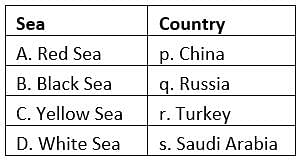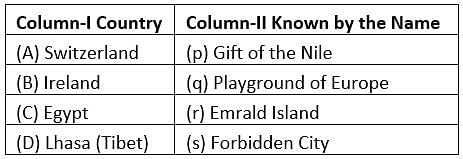Class 7 Exam > Class 7 Tests > Olympiad Test Level 2: World Geography- 1 - Class 7 MCQ
Olympiad Test Level 2: World Geography- 1 - Class 7 MCQ
Test Description
10 Questions MCQ Test - Olympiad Test Level 2: World Geography- 1
Olympiad Test Level 2: World Geography- 1 for Class 7 2024 is part of Class 7 preparation. The Olympiad Test Level 2: World Geography- 1 questions and answers have been prepared
according to the Class 7 exam syllabus.The Olympiad Test Level 2: World Geography- 1 MCQs are made for Class 7 2024 Exam.
Find important definitions, questions, notes, meanings, examples, exercises, MCQs and online tests for Olympiad Test Level 2: World Geography- 1 below.
Solutions of Olympiad Test Level 2: World Geography- 1 questions in English are available as part of our course for Class 7 & Olympiad Test Level 2: World Geography- 1 solutions in
Hindi for Class 7 course.
Download more important topics, notes, lectures and mock test series for Class 7 Exam by signing up for free. Attempt Olympiad Test Level 2: World Geography- 1 | 10 questions in 20 minutes | Mock test for Class 7 preparation | Free important questions MCQ to study for Class 7 Exam | Download free PDF with solutions
Olympiad Test Level 2: World Geography- 1 - Question 1
The Fluvial Landforms are created by ___
Detailed Solution for Olympiad Test Level 2: World Geography- 1 - Question 1
Olympiad Test Level 2: World Geography- 1 - Question 2
The canal joining Baltic Sea to North Sea is
Detailed Solution for Olympiad Test Level 2: World Geography- 1 - Question 2
| 1 Crore+ students have signed up on EduRev. Have you? Download the App |
Olympiad Test Level 2: World Geography- 1 - Question 3
Match the seas with the coastal countries.


Olympiad Test Level 2: World Geography- 1 - Question 4
The Dead Sea is located between which two countries?
Detailed Solution for Olympiad Test Level 2: World Geography- 1 - Question 4
Olympiad Test Level 2: World Geography- 1 - Question 5
Which of the following regions of the world is called as Natural Zoo of the World?
Detailed Solution for Olympiad Test Level 2: World Geography- 1 - Question 5
Olympiad Test Level 2: World Geography- 1 - Question 6
There are various countries in Northern Europe on the border of the Baltic sea. Which among the following does not share a border with the baltic sea?
Detailed Solution for Olympiad Test Level 2: World Geography- 1 - Question 6
Detailed Solution for Olympiad Test Level 2: World Geography- 1 - Question 7
Olympiad Test Level 2: World Geography- 1 - Question 8
Which of the following statements is/are correct about Eiffel Tower?
Detailed Solution for Olympiad Test Level 2: World Geography- 1 - Question 8
Olympiad Test Level 2: World Geography- 1 - Question 10
Which regions are called 'Orchards of the World'?
Detailed Solution for Olympiad Test Level 2: World Geography- 1 - Question 10
Information about Olympiad Test Level 2: World Geography- 1 Page
In this test you can find the Exam questions for Olympiad Test Level 2: World Geography- 1 solved & explained in the simplest way possible.
Besides giving Questions and answers for Olympiad Test Level 2: World Geography- 1, EduRev gives you an ample number of Online tests for practice
Download as PDF


















